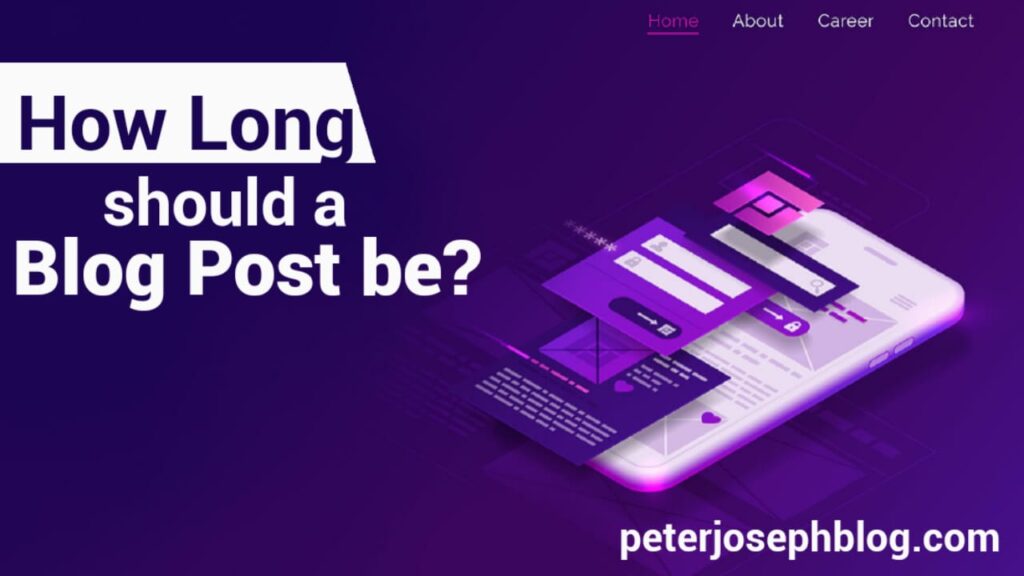Creating a blog is a fantastic way to share your thoughts and ideas with the rest of the world. Blog postings, aside from being a creative outlet, can also result in significant website traffic, social media shares, and backlinks.
To get the most out of your articles, they need to be well-written and of the right length. This raises the important question of “how long should a blog article be?”
In the last few years, you’ve probably heard SEO gurus mention the word “E-A-T.” When it comes to ranking businesses and their websites on search, Google considers three golden standards: expertise, authority, and trustworthiness.
If you want to climb the ranks, your brand should demonstrate experience, an authoritative vision, and be trustworthy.
How Long Should a Blog Post be?

Knowing how long to write material is an important aspect of your strategy for success if you are just starting a blog or if you are an experienced blogger. Let’s see how many words are required to reach the best blog post available.
As it becomes more vital to grow your brand, content marketing has changed significantly over the previous decade. If you’ve been paying attention, you’re aware that the length of your blog has a direct impact on your organic SEO.
On average, content with over 1,000 words ranks higher in the search for highly relevant keywords. Writing content between 1,000 and 1,500 words is a decent guideline. To avoid being labeled as having “thin content,” blog articles should include at least 300 words.
Should You Write a Long Blog to Rank Higher?
Blogging is one of the oldest and most crucial components of a content strategy for a company. You can generate relevant visitors to your website by blogging, and it’s also a great method to keep your material current for SEO purposes. New material gets more attention from Google. Blogging is the process of regularly posting new content to your website.
Blogs also provide visitors a cause to come back to your site again and again. Blogs are typically written in a conversational and educational tone to teach their audience.
There is no one-size-fits-all formula for creating the finest blog content. Keywords, writing style, design, format, image, snappy subheadings, and overall user experience are all components of a good blog post.
Why Create Long Blog Posts?
Although the length of your material has no direct impact on your website’s ranking, blogging can help you increase your visibility, audience engagement, and brand awareness. Readers will be delighted to read stuff that they value.
To target long-tail keywords, you may need to create longer content and provide greater coverage of the topic at hand, hence expanding your reach.
Adding more useful/reference links can also improve the article’s value. Include a few data or studies to back up your claim. This improves the article’s credibility.
Different lengths of blogs and their value
There’s a misconception that the shorter the blog post, the more likely it will be read. We’re here to dispel this fallacy and correct the record!
Here are the various blog lengths and their respective values.
Less than 300 words: Blog entries under 300 words are rarely suggested. If and when they are employed, it is primarily to generate conversation to receive feedback. This duration is ineffective for SEO and social media sharing.
300 – 600 words: In the past, the length of a blog article was considered “normal.” Now, this word limit is insufficient for demonstrating authority and ranking on search engines because it does not allow you to go into depth on a topic.
600 – 800 words: Professional journalism and newspaper stories frequently use this range. Also included in this word count limit are product descriptions and encyclopedia entries. These articles have the potential to generate shares and backlinks.
800-1000 words: These are instructional articles written in a journalistic style. These postings are ideal for incorporating influencers, reference links, and gradually increasing SEO.
1000-1500 words: These longer pieces, depending on your readership, can have a significant impact on lead conversion. When it comes to driving organic website traffic, length is a significant tool when it comes to link development, collaborations, and calls to action.
1500-1700 words: Frequently, “What is…” blog posts can be found here. You’ll notice a lot more social media shares and instructional helpful content that generates backlinks as you enter this zone. Influencers who publish promotional posts frequently use this word length.
1700-2100 words: This is the optimal length for “How to…” posts on your blog. Additionally, you’ll start to notice high lead conversion and organic search traffic opportunities here.
2100-2500 words: Because search engines prefer longer content, these articles are referred to as “Google go-getters.” The highest-ranking postings are said to be 2,450, so that could be Google’s sweet spot. Include a lot of relevant reference links to influencers, educate your audience, and include downloadable information if you want to acquire organic search traffic.
Determining your Audience
Knowing your target, focusing on the reader, and understanding their objective are all great practices for producing the correct length post. Put yourself in their place and envision how much information they want and hope to receive, and you’ll be better equipped to determine the appropriate average blog post length for your content.
It’s crucial to examine if the audience is new to the topic or already knowledgeable about it. Their degree of understanding can help you determine whether you need to provide a lot of background information before stepping in, how far into a topic you need to go, and how many words it will take.
Choose the Right Topic
Do your research and come up with fascinating and amusing topics for your readers. Tools like Google Keyword Planner may help you figure out what keywords your target audience is searching for, and a fast Google search using these keywords can show you what kind of material is being written about it.
If you have more time, go the extra mile and conduct a social media search. Examine the most popular kind of material.
Purpose of the article
Before you begin writing, consider what you want your audience to take away from this post. The majority of blogs are published to educate, inform, and entertain their readers. This assists in increasing and improving customer interaction with your brand.
You will know exactly how to write your essay if you know what you want to achieve with it.
Target the correct audience
It will be easier to assess what type of content your audience responds to if you know who they are. Do they respond well to lengthy pieces, or do they prefer content that is brief and to the point? Consider the age, gender, and expectations of your target audience.
Use clearly headings and sections
Readers will stay on your site longer if you use good headings since they will be able to traverse the blog article more easily and find exactly what they need, rather than becoming overwhelmed and leaving. To present your major points, insert a table of contents at the top of your article, such as the one seen at the beginning of this section.
Break paragraphs to use images
Using photos in your blog articles has two major advantages. First, research has shown that bloggers who use ten or more photographs in their blog posts get better results. Second, visuals are an excellent method to break up long passages of the text without overwhelming or boring the reader. “A picture is worth a thousand words,” as the saying goes, and can thus aid in conveying your message. Finally, remember to include alt text in your photographs for both accessibility and image SEO.
Conclusion
It’s difficult to know how long to spend on your blog. We understand.
Writing a blog, whether lengthy or small, takes a lot of time and should be done correctly.
You can focus on high-value tasks like building your business when you spend less time writing quality blogs. Let us take care of the blogging business.
What is the appropriate length for a blog post? We’d be delighted to hear from you.



























